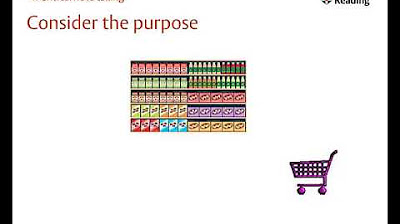Why and how to make notes for studying maths
Summary
TLDRThe transcript emphasizes the importance of effective note-taking for enhancing memory, especially for students progressing to higher academic levels. It suggests that merely reading notes is insufficient; instead, students should actively engage by writing their own notes, which aids in better retention. The speaker advocates for creating personalized notes from various resources, highlighting the significance of understanding and memorizing formulas as 'shortcuts' in mathematics. Additionally, the speaker recommends including key examples and solutions in notes, encouraging students to dissect and encode these examples to improve their understanding and memory.
Takeaways
- 🧠 Your memory is a hard worker and is important for managing multiple subjects.
- 📝 Making notes is the first step in helping your memory.
- 📚 Reading someone else's notes or textbook notes is better than nothing, but it's only a basic level of learning.
- ✍️ Copying notes by hand (not typing) is more effective than just reading because it engages active thinking.
- 🖋️ It's even better to create your own notes by gathering information from different sources like textbooks, worksheets, and friends.
- 🔢 For subjects like math, focusing on formulas (shortcuts) is important. They save time by providing quick solutions.
- 🔧 Formulas are essentially shortcuts that simplify complex calculations, making problem-solving faster.
- 📐 In math, learning how to use formulas, like the one for calculating a side in a triangle, can make problem-solving more efficient.
- 🎯 Key examples and tough questions should be included in your notes to help you practice and highlight important steps in solutions.
- 🎨 Use highlighting, colors, and other visual aids to emphasize important steps in your notes and make them easier to remember.
Q & A
What is the primary advice given for improving memory when studying?
-The primary advice is to make notes, as it helps in retaining information better than just reading notes or textbooks.
Why is it beneficial to take your own notes instead of reading someone else's?
-Taking your own notes is beneficial because it involves active engagement with the material, which helps in better understanding and remembering the content.
What is the significance of copying notes by hand rather than typing them?
-Copying notes by hand is suggested to be more effective because it engages the brain differently and can aid in memory retention.
How does creating your own notes from various resources enhance learning?
-Creating your own notes from different resources like textbooks, worksheets, and friends' notes allows for a more comprehensive understanding and personalized learning experience.
What role do formulas play in studying mathematics according to the script?
-Formulas are considered as shortcuts that simplify complex calculations and should be included in notes for quick reference and better understanding.
Why is it recommended to think of formulas as shortcuts rather than something to memorize?
-Thinking of formulas as shortcuts helps in understanding their utility and makes them easier to remember, as opposed to viewing them as tedious memorization tasks.
What is the importance of including key examples in your notes?
-Including key examples in your notes helps in understanding how to apply concepts and formulas to solve problems, making the learning process more practical and effective.
How can highlighting and underlining be useful when studying from your notes?
-Highlighting and underlining help in identifying and remembering important steps and concepts within solutions, making it easier to recall and apply them later.
What does the speaker suggest as a method to better understand and remember complex problems?
-The speaker suggests dissecting tough problems into steps, understanding the logic behind each step, and then encoding or marking these steps in your notes for better retention.
Why is it important to use different colors and markings when creating notes?
-Using different colors and markings can help in visually distinguishing between various types of information, such as steps in a solution or different concepts, thereby enhancing memory and comprehension.
What is the overall strategy for effective note-taking as described in the script?
-The overall strategy for effective note-taking involves actively engaging with the material by creating personalized notes, using them to understand and remember key concepts and formulas, and employing visual aids to enhance learning and recall.
Outlines

This section is available to paid users only. Please upgrade to access this part.
Upgrade NowMindmap

This section is available to paid users only. Please upgrade to access this part.
Upgrade NowKeywords

This section is available to paid users only. Please upgrade to access this part.
Upgrade NowHighlights

This section is available to paid users only. Please upgrade to access this part.
Upgrade NowTranscripts

This section is available to paid users only. Please upgrade to access this part.
Upgrade Now5.0 / 5 (0 votes)





